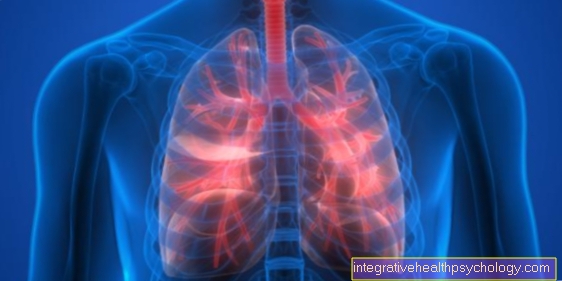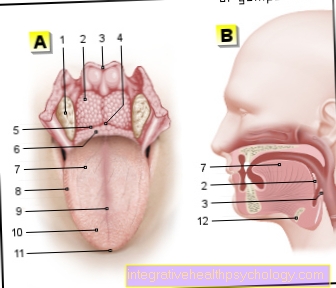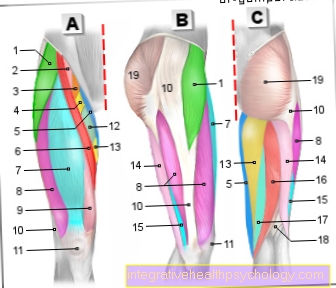Tetraspastic
definition
Tetraspasticity is a kind of paralysis of all four extremities - the arms and legs. This is characterized by strong tension in the muscles, which often causes the body to tense up in unnatural postures. It often arises from a flaccid paralysis and can also affect the trunk and neck or head muscles.

Concomitant symptoms
There are typical accompanying symptoms that are associated with tetraspasticity. This includes sensory disturbances such as decreased temperature and pain sensation and numbness of the affected body regions.
In addition, the reflexes are impaired. They are usually much stronger and have wider reflex zones, so that e.g. the patellar tendon reflex can already be triggered by tapping the shin and there are often pathological reflexes in this context, such as the so-called Babinski reflex, which should only be triggered in babies.
Inexhaustible twitching of certain parts of the body can also occur (Clone). If the throat and tongue muscles are affected, speech disorders often occur. In the event that the damage is so severe that the C4 spinal cord segment is affected, it can lead to severe paralysis of the diaphragm, which would lead to respiratory failure.
Read more on this topic at: Causes of Clonies
therapy
Treatment for tetraspasticity usually consists of treating the underlying condition. However, since most of these diseases are not (yet) curable, tetraspasticity usually cannot be cured either. Intensive physiotherapy is important for the affected patients in order to avoid or reduce consequential damage from postural disorders.
Medicinal treatments can also be used for severe spasms. Muscle relaxants that take the tension out of the muscles come into question here. The neurotoxin botox is also often used for this, as it can achieve considerable success over a period of time.
However, those affected should be aware that these forms of therapy only serve to alleviate the symptoms and improve the quality of life; they do not combat the cause and are therefore not a cure.
Read more about this: What possibilities are there to solve a spasticity?
physical therapy
Physiotherapy is a central component of therapy in tetraspasticity. It not only prevents consequential damage such as bad posture, shortened muscles or athrosis, but can also have a positive effect on communication from nerve to muscle. Good physical therapy, individually tailored to the problem, can at least partially restore mobility and often helps to relieve pain. The treatment usually consists of therapy schemes according to Vojta or Bobath combined with procedures such as heat therapy or the like, as well as targeted movement and stretching of the muscles. Therapy plans must always be tailored to the problem at hand in order to achieve maximum success.
Occupational therapy
Occupational therapy can be an appropriate therapeutic tool for patients with tetraparesis. The focus here is particularly on being able to reintegrate the patient into a "normal" life as quickly as possible. By means of different concepts, not only the muscles and posture, but also the perception, psyche and communication skills are strengthened. This makes it easier for patients to cope with their illness and at the same time reduces symptoms and side effects.
Botox
Botulinum toxin, popularly known as "Botox", is a nerve poison that originally consists of bacteria (Clostridium botulinum) originates. This highly effective substance affects the transmission of signals from the nerves to the muscles and thus unfolds its toxic effect. Among other things, it is used in very low doses in spasm therapy and can therefore be used as a drug. The tension in the muscles decreases and the spasm subsides. Botox is injected into the affected muscles and takes effect after a few days. This can be accompanied by an impressive improvement in symptoms over a period of up to 6 months. However, it should be noted that the body becomes resistant to Botox over time, so that it cannot be used indefinitely.
Read more on this topic at: Botox
Care for those affected?
Patients suffering from tetraspasticity can be affected to different degrees. Those who are struggling with severe disabilities often need nursing support, if not completely cared for. Nursing care can help to cope with everyday activities if the independence is still partially available and ensures that patients with severely restricted mobility are cared for as best as possible. Nursing care for people affected by spasticity requires good training and must always be adapted to the individual problems and challenges.
forecast
Tetraspasticity is a chronic condition and therefore incurable. Since the cause is based on damage to the central nervous system, no elimination of the disorder is possible here. The course of a tetraspasticity can, however, vary greatly from person to person. The disease progresses at different speeds depending on the patient. Over time, however, the symptoms can be expected to worsen if they have not already reached their maximum. Many patients are confined to a wheelchair in the course of their underlying disease. This deterioration can often be delayed and the quality of life can be maintained for a relatively long time with medication and physiotherapy.
What is the life expectancy with a tetraspastic?
The life expectancy of a tetraspastic is not easy to determine. It depends heavily on the underlying disease. If the paresis is due to a traumatic cause (i.e. an accident or the like), then life expectancy is usually hardly or not at all influenced; the patient only has to struggle with his limitation.
This can be different for other underlying diseases. Tumors that cause tetraparesis often do not have a good prognosis, but this must be determined individually. According to a Canadian study, multiple sclerosis can be expected to reduce life expectancy by around seven years; Those affected reach an average of 77 years of age.
In general it can be said that tetraspasticity does not usually lead to death, but the progression of the underlying disease is responsible for it and therefore a statement about life expectancy can only be made in connection with the medical history. An exception is such a spasticity, which has its cause above the fourth cervical vertebra: Since this is where the nerves (C3-5) originate that supply the diaphragm, life-threatening respiratory arrest often occurs. This is an absolute emergency and, if left untreated, leads to death.
causes
The cause of tetraspasticity is always damage to the central nervous system. This can have various causes and develop differently: For example, in the course of a traumatic event (e.g. fall from a great height), damage to the spinal cord can occur, which initially results in flaccid paralysis, the so-called spinal shock can continue into tetraspasticity within 6-8 weeks.
Another possibility are chronic courses, which are triggered by slowly progressing diseases. These are, for example, tumors that spread to the nervous system, multiple sclerosis (MS) or inflammation of the nerve sheaths, known as myelitis. Those clinical pictures are usually characterized by a creeping course and a steady worsening of the spasticity. A rather rare cause is infantile cerebral palsy.
Multiple sclerosis (MS)
Multiple sclerosis is a disease of the central nervous system. This results in inflammatory damage to the so-called myelin sheaths of the nerves and thereby also the nerves themselves. The myelin sheaths are important for isolating the nerves and for the rapid transmission of impulses.
MS often progresses in bursts, which can cause new neurological symptoms to appear quite suddenly, some of which disappear again after a while, but it can also take a chronic course, with the symptoms becoming more and more severe. Tetraspasticity can be one of the symptoms of multiple sclerosis. If this is the case, the severity depends on the form, which can be either intermittent or chronic. Typically there are also disorders of the eyes, sensory disorders, damage to the cranial nerves and other symptoms. In general, the clinical picture varies greatly from person to person.
- For more information, see:
- multiple sclerosis
- Course of Multiple Sclerosis
diagnosis
Tetraspasticity usually does not represent a clinical picture of its own, but only the symptom of another disease, which is why no real diagnosis of tetraspasticity is made. In general, it is characterized by a strong tension in the muscles, which forces the body into unnatural positions. It starts from both arms and legs and can also affect the trunk and neck. This is often noticeable at first glance, at the latest in a physical or neurological examination.




























